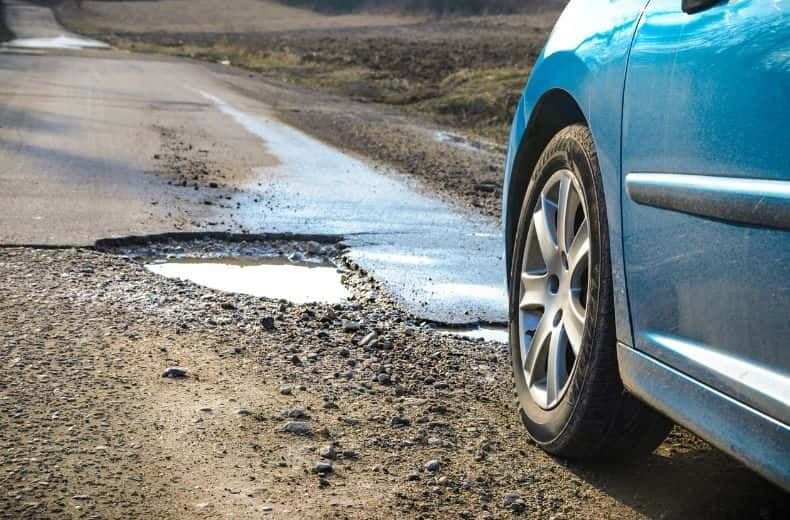The UK is thought to have more than one million potholes, with these road defects being one of the leading causes of car breakdowns. Currently, the Government has a pot of £1.6 billion to tackle the problem up until the end of 2026.
But what is the current state of our roads? Find out with the RAC Pothole Index.
How many potholes are there in the UK?
Each year the RAC estimates drivers have to battle against at least one million potholes on the country’s roads, but the actual number will vary from season to season.
It is estimated that, on average, there are around six potholes per mile on council-controlled roads in England and Wales.
In 2023, separate data obtained through a Freedom of Information (FOI) request provided a glimpse into the scale of the UK's pothole problem.
The FOI request was sent to all of England's 185 county and district councils, with 81 providing a response. Of these, 556,658 potholes were reported in England in the financial year of 2021/22 - a figure that would be far higher if every councils had provided data.
It's important to note that the FOI request did not include road defects within Wales, Scotland and Northen Ireland - this means the true number of potholes in the UK is likely to be two or three times higher than the 556,658 that was reported.
What's more, between 2022 and 2023, 1.4 million potholes were filled in England and Wales - down from 1.7 million the year before.
(Sources: Liberal Democrats, GOV.UK, Asphalt Industry Alliance)
Current state of UK’s pothole problem in data and statistics
Pothole-related vehicle breakdowns surged to an unusual high in Q2 2025, with RAC patrols responding to 9% more incidents than during the same period last year, according to the latest figures.
Between April and June, the RAC attended 6,575 breakdowns involving damaged shock absorbers, broken suspension springs, and bent wheels – issues typically linked to deteriorating road surfaces.*
This marks an increase from 6,050 cases in Q2 2024, and aside from the notoriously harsh first quarter, it's the highest quarterly total since Q2 2023.**
The broader trend paints a troubling picture for UK motorists.
Over the 12 months leading up to 30 June 2025, RAC patrols handled 24,763 pothole-related breakdowns (averaging 68 per day), which is more than 500 additional incidents compared to the year ending March 2025.
Among the three most common types of pothole damage, broken suspension springs were the most frequent, likely due to their role in absorbing road shocks.
In Q2 2025, RAC responded to 4,779 such breakdowns, a 23% rise from the 3,887 cases recorded in the same period last year.
Notably, more drivers are choosing to have these repairs done at home by RAC’s mobile servicing team rather than visiting a garage.
The RAC attributes this spike to colder-than-average weather in early 2025, which accelerated pothole formation.
When water seeps into cracks in untreated roads and freezes, it expands – worsening surface damage.
Finally, pothole-related incidents accounted for 1.2% of all RAC breakdowns in Q2 2025, the highest proportion in seven years, up from 1% in Q2 2024.
Drivers whose vehicles have suffered broken suspension springs can now get them replaced by RAC Mobile Mechanics on their driveways or at their workplaces rather than having to go to a garage. To book an RAC Mobile Mechanic to replace a broken suspension spring, call 0333 070 2784.
RAC head of policy Simon Williams said: “Although English councils received a record amount of funding for roads at the start of the new financial year in April, it’s too early to notice the benefit of increased maintenance programmes.
“We can clearly see the cold winter weather at the start of the year has left its mark and caused an ‘unseasonable high’ in breakdown volumes during a quarter when we’d typically expect a reprieve.
“With second-quarter RAC call-outs 9% higher than the same period last year, we hope English councils have been putting their allocated funding pots to good work in the summer surface dressing season which runs from April to September. We hope drivers will soon start to see the results of both the preventative maintenance and resurfacing works they have done.
“We’re urging all highways authorities to think ‘prevention over patching’ when it comes to their maintenance work. After filling the most severe potholes as permanently as possible, preventative treatments like surface dressing are by far the most effective because they stop potholes appearing in future. Now councils have long-term certainty of funding, they can plan surfacing dressing works, along with resurfacing roads that are beyond repair.”
Mike Hansford, chief executive of the Road Surface Treatments Association, said: “Untreated asphalt roads will naturally degrade over time, leading to the formation of potholes. It is essential to invest in cost effective preventative road surface treatments to seal the road; preventing water ingress, and to act as a barrier to the elements and the effects of trafficking, keeping roads in good condition for longer and preventing potholes.”
Separate RAC data found drivers are still directly paying the price of poor road surfaces. Looking at the types of unexpected motoring repair costs, a fifth (21%) said they had to fork out for new suspension parts such as shock absorbers and springs which are most commonly damaged by potholes.*** This figure rises to 30% for those driving cars between three and 10 years old.
* The RAC Pothole Index is a 12-month rolling measure of the share of pothole fault breakdowns compared to 2006, corrected for seasonal weather effects and improving longer term vehicle reliability. Data has been collected by the RAC since 2006. Data deliberately excludes punctures as the source of these could be something unrelated to road standard (for instance, the presence of nails and screws)
** 2024 April – December call-outs for damaged shock absorbers, broken suspension springs and distorted wheels: Q2 - 2,148; Q3 - 1,383; Q4 - 1,595
*** Research conducted with 2,691 drivers by Online95 for the RAC Report on Motoring 2024. Only those who hold a full, current UK driving licence, drive at least once a month and have a motor vehicle in their household took part. Responses were rim-weighted to be nationally representative of UK motorists in age, gender, socio-economic groups and all UK regions. Effective sample size 1,925 drivers.
Pothole-related breakdowns – in numbers
| 2020 | 2021 | 2022 | 2023 | 2024 | |
|---|---|---|---|---|---|
| Total pothole-related breakdowns | 21,725 | 31,146 | 22,095 | 29,377 | 22,703 |
| Likelihood of breaking down, compared to 2006 (RAC Pothole Index) - ie 2.0 means twice as likely | 1.44 | 1.63 | 1.54 | 1.69 | 1.39 |
- RAC pothole-related breakdowns on the rise
- The Highway Code – common road signs and what they mean
- Mobile phone while driving data page - all you need to know
National Pothole Day 2025
The Future of Roads Minister, Lilian Greenwood, marked National Pothole Day (15 January 2025) with a visit to the JCB Factory near Derby to explore innovative technology that is helping local councils address pothole issues.
Derbyshire, which the RAC has identified as the worst region in England for potholes, will benefit from part of the government’s historic £1.6 billion investment in resurfacing projects across the country.
This funding includes an extra £20 million for the East Midlands County Combined Authority, which covers Derbyshire, as part of the £1.6 billion allocated for highway maintenance. The investment will help councils repair up to 7 million additional potholes.
Greenwood, said: "Potholes are a clear sign of decline in our infrastructure and for too long roads like those in Derbyshire have been left in a state that endangers and costs road users.
"It’s time for change and we are investing £1.6 billion to fix up to 7 million more potholes across England this year, including over £75 million for the East Midlands Combined Authority.
"JCB’s ‘pothole pro’ is one of the many great examples of using new technology to repair potholes faster and demonstrates how companies are harnessing new technology to repair potholes faster.
"We’ll continue to engage with local leaders and industry to ensure innovations are being used to deliver roads the country deserves."
Why are they called potholes?
Historians have established that the term ‘pothole’ comes from the age of the Roman Empire.
Potters who couldn’t afford clay would often steal it from the Roman roads as they were built on top of a heavy layer of clay – causing deep holes in the road surface.
Although the meaning and attribution to its popularity in English vernacular has evolved over time, it has always led back to the description of a crack, imperfection or hole on a road or walkway.
The name ‘pothole’ is used because these road surface depressions often resemble small craters or holes, similar to the shape of a pot or container. However, their shape can vary quite a lot.
What causes potholes?
Potholes typically occur when the road surface deteriorates due to various factors such as temperature changes, water seepage, and repeated traffic impact.
The combination of these factors weakens the road surface, leading to the formation of these depressions or holes.
They can vary in size and depth, ranging from small divots to larger craters that can pose a risk to vehicles and pedestrians. They are a common road maintenance issue and can be found in many parts of the world, not just in the UK.
Potholes are primarily caused by a combination of several factors, including:
- Freezing and thaw cycles: In regions with colder climates, water can seep into cracks and pores in the road surface. When this water freezes, it expands, exerting pressure on the surrounding road and causing it to crack. When the ice melts, it leaves behind gaps and voids, weakening the road structure and leading to the formation of potholes. This is a common issue in the UK.
- Heavy traffic and vehicle loads: Repeated traffic, especially from heavy vehicles, can accelerate the deterioration of road surfaces. The constant weight and impact of vehicles can weaken the road, causing cracks to form. Over time, these cracks can develop into potholes. Over the last decade, there has been a drastic increase in traffic – and in the size of vehicles people are driving.
- Water damage: Water is a major contributor to pothole formation. It can infiltrate the road structure through cracks or poorly sealed joints. The presence of water weakens the underlying layers, causing the road surface to lose its structural integrity and resulting in pothole development.
- Age and wear: Over time, road surfaces naturally degrade. The constant exposure to traffic, weather elements, and environmental factors gradually erodes the road materials. As the road becomes more worn and brittle, it is more susceptible to cracking and the eventual formation of potholes. All roads should be updated and kept in working condition – however, this is where a lot of the problems in the UK stem from.
- Poor construction or maintenance: Inadequate road construction practices, improper compaction of materials, or insufficient maintenance can contribute to the formation of potholes. If roads are not built to withstand the stresses they encounter or if maintenance activities are neglected, it can accelerate the deterioration process.

RAC sale – up to 33% off*
• Roadside cover from £5.29 a month†
• We get to most breakdowns in 60 mins or less
• Our patrols fix 4/5 breakdowns on the spot

Why does the UK have so many potholes?
The UK’s wet and cold climate makes its roads susceptible to potholes. The UK’s high traffic levels also increase road wear, which means the roads are more likely to become cracked or damaged. Most of the UK’s potholes form in the winter months, with water seeping into the road via small cracks which form a pothole when it freezes and forces the road surface to break up.
Where are the most potholes in the UK?
Cities and urban areas with heavy traffic tend to experience more wear and tear on their road infrastructure, making them more prone to potholes. Areas with significant urban centres like London, Manchester, Birmingham, Cardiff, and Glasgow may have a higher occurrence of potholes due to the increased traffic density.
Regions that experience severe weather conditions, such as heavy rainfall or freezing temperatures, are more susceptible to the formation of potholes. This is particularly true in areas of the UK that have colder climates, such as Scotland, northern England, and the northern parts of Wales.
Adding to this, roads in rural or less densely populated areas may receive less frequent maintenance and repairs compared to major highways and urban roads. These can often be in the colder areas of the country.
It's important to note that the situation can change over time as road maintenance efforts and infrastructure investments are made. Local authorities and highway agencies are instructed by the Government to address potholes and improve road conditions across the UK.
However, the data requested through the FOI showed the councils that are the worst impacted by potholes.
Derbyshire had the most potholes per region, with 90,596 – followed by Lancashire (67,439) and Northumberland (51,703).
The area with the longest average time to fix individual holes was Stoke-on-Trent, with a massive 657 days. This was followed by Westminster (556 days) and Norfolk (482 days).
(Source: FOI by the Liberal Democrats)
How much does the Government spend each year on potholes?
Millions of drivers will benefit from safer roads thanks to a £1.6 billion investment announced by the government to repair roads and fill potholes. This investment – nearly 50% more than last year’s funding for local road maintenance – exceeds the government’s manifesto commitment and is sufficient to fix over 7 million additional potholes in 2025-2026.
Each local authority will use its share of the £1.6 billion for 2025-2026 to prioritise roads most in need of repair, providing immediate fixes for communities and improving living standards across the country.
As part of its Plan for Change, the government is providing an additional £500 million in funding to local highways authorities across England. Fixing potholes and repairing roads not only enhances safety but also improves journey times and helps drivers avoid costly repairs.
RAC data reveals that drivers in England and Wales encounter an average of 6 potholes per mile, with the cost of pothole damage to vehicles averaging £460, and more severe repairs often running much higher.
Prime Minister, Sir Keir Starmer, said: "Broken roads can risk lives and cost families hundreds if not thousands of pounds on repairs. That’s a cost that can easily be avoided by investing properly in our roads.
"Through our Plan for Change we’re determined to put more money back into the pockets of hardworking people and improve living standards. That’s why we’re giving councils funding to repair our roads and get Britain moving again – with a clear expectation that they get on with the job."
How likely are you to suffer a breakdown due to a pothole?
The likelihood of a vehicle breaking down due to a pothole depends on various factors, including the severity of the pothole, the speed and angle at which the vehicle hits it, the condition of the vehicle, and the type of road surface.
RAC Pothole Index data - see below - shows that UK drivers are more likely to break down as a result of a pothole today than they were in 2006, when data was first collected.
While smaller potholes may not cause significant damage, larger or deeper potholes can pose a greater risk.
However, hitting many smaller potholes over time can impact your vehicle in a negative way.
Some potential issues that can arise from hitting a pothole include:
- Tyre damage: Potholes can cause punctures, sidewall bulges, or tyre blowouts if the impact is severe enough.
- Wheel and suspension damage: Hitting a pothole with force can result in bent or cracked wheels, misalignment, or damage to suspension components, such as shocks, struts, or control arms.
- Steering system problems: The impact of a pothole can affect the steering system, leading to misalignment, steering wheel vibration, or difficulty in steering.
- Exhaust or undercarriage damage: Particularly deep potholes may cause the underside of the vehicle to hit the road surface, resulting in damage to the exhaust system, oil pan, or other components.
- Losing control of the vehicle: A cause for many accidents can be attributed to the impact of a driver travelling over a pothole. They are a hazard to all road users.
According to RAC data, it is advisable to exercise caution and try to avoid potholes whenever possible and regular vehicle maintenance can also help identify any issues that may arise from pothole impacts.
If you encounter a pothole while driving, it is recommended to slow down and cautiously navigate around it if it is safe to do so. If you suspect any damage to your vehicle after hitting a pothole, it is advisable to have it inspected by a qualified mechanic to address any potential issues.
You can also report a pothole quickly and easily from the RAC website.
When looking at RAC data, it can be summarised that although pothole-related breakdowns have fallen over the last decade, they have risen since pre-pandemic levels.
UK potholes map 2025
The RAC is working with Metricell, developers of the Stan mobile app, to build a picture of the quality of roads across the country.
How much does it cost to repair a car after hitting a pothole?
Pothole repairs can be costly for drivers. RAC garage data from December 2023 shows that for anything more serious than a puncture, drivers can expect to have to pay up to £460 if their car needs to go to a garage after hitting a pothole.
Council pothole compensation claims double in 2023
Pothole compensation claims submitted to 18 local authorities with the longest road networks in Britain more than doubled in the 12 months between 2022 and 2023 from 8,327 to 20,432, new data analysed by the RAC has revealed.
A Freedom of Information request to 21 councils – covering nearly 92,200 miles of local roads – found that of the 18 that responded, Surrey County Council saw the biggest increase in claims, from 734 in 2022 to 3,418 in 2023. Hampshire County Council was a close second, where claims jumped from 750 in 2022 to 2,654 last year, followed by Gloucestershire County Council, where claims rose from 257 in 2022 to 829 in 2023.
Despite the huge rise in year-on-year claims, 17 councils paid out just 15% (3,131) of the 20,432 claims submitted by drivers in 2023. The RAC estimates this equates to a total of around £824,000 paid out at an average of just £260 per claim. This is around 43% less than the amount drivers can expect to pay – up to around £460 – if their car needs to be fixed for anything more serious than a puncture, according to RAC garage data.
The data also shows that the chances of making a successful claim for pothole compensation are very limited, as 76% (13) of the 17 councils that paid drivers any compensation for pothole damage refused more than three-quarters of the claims they received in 2023.
And, according to the FOI data shared with the RAC, five councils refused nine-in-10 pothole claims in 2023. Gloucestershire County Council refused 98% of its 829 claims; Essex County Council refused 95% of its 2,560 claims; Kent and Cornwall Councils both refused 92% of their 1,884 and 407 respective claims and Powys County Council refused 90% of its 107 claims.
Surrey refused the greatest number of pothole compensation claims last year, turning down 86% (2,954) of the 3,418 claims it received in 2023.
Only Shropshire Council paid more than 30% of the compensation claims it received, paying 68% of its 546 claims in 2023.
The numbers also show that as pothole damage claims have increased, the proportion of claims refused by councils has risen slowly too. Between 2021 to 2023, the average number of claims refused has risen by five percentage points, from 76% to 81%.
Councils refused seven-in-10 claims because they didn’t know potholes were there
The RAC also asked councils how many claims for compensation they refused due to the authority saying it was not aware of the existence of the potholes in question, under Section 58 2d of the Highways Act 1980. Of the 8,172 compensation claims refused by the nine councils that provided data for this question, an overwhelming majority – 74% (6,028) – were refused on Section 58 grounds in total.
Gloucestershire and Hertfordshire councils both stated that every single claim (100%) they refused was because they did not know that a particular pothole existed.
Read more: Council compensation for potholes in the UK

RAC sale – up to 33% off*
• Roadside cover from £5.29 a month†
• We get to most breakdowns in 60 mins or less
• Our patrols fix 4/5 breakdowns on the spot

The RAC Guide to the Great British Pothole and Other Road Surface Defects
Different types of potholes
The Great British Pothole
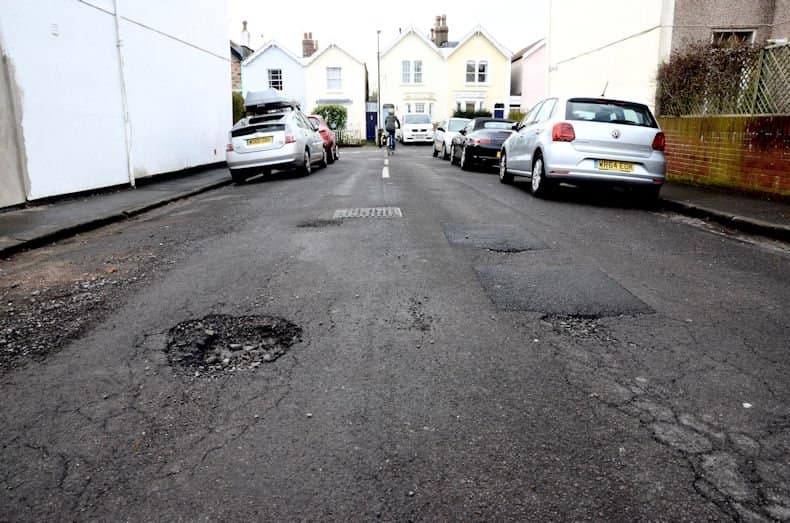
Sometimes also referred to as The Classic. Sadly needs no introduction. More common in town centres than pigeons.
Encountered in varying depths and sizes, causing all kinds of damage and dangers. Needs repairing as soon as it becomes dangerous, but would benefit from a ‘permanent fix’ as opposed to the customary ‘patch and dash’.
The Alcatraz
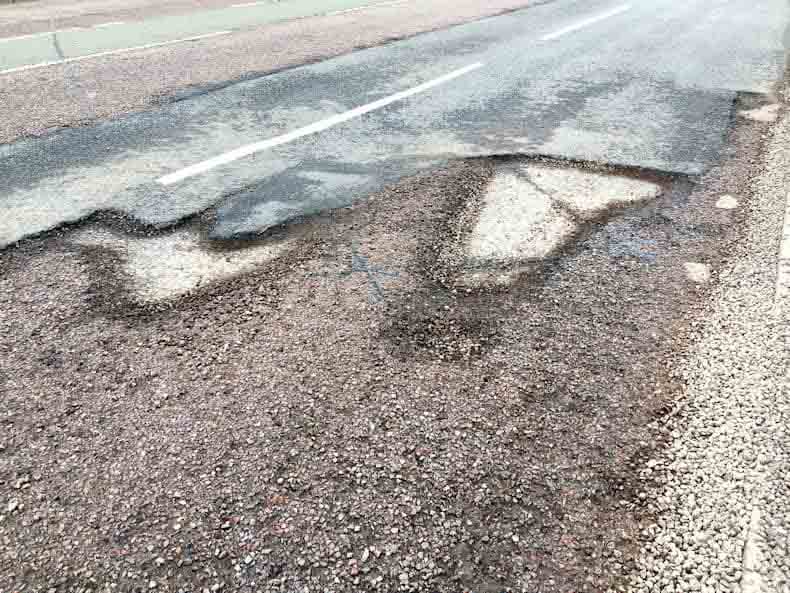
There’s no escaping this one. A pothole, or cluster of potholes, that are extremely difficult to avoid due to their size, location or number.
The damage one of these could cause to a vehicle may not be criminal, but it surely must come close. And the thought of someone on two wheels hitting one is beyond frightening.
Report a pothole and claim for damage here
The Slalom
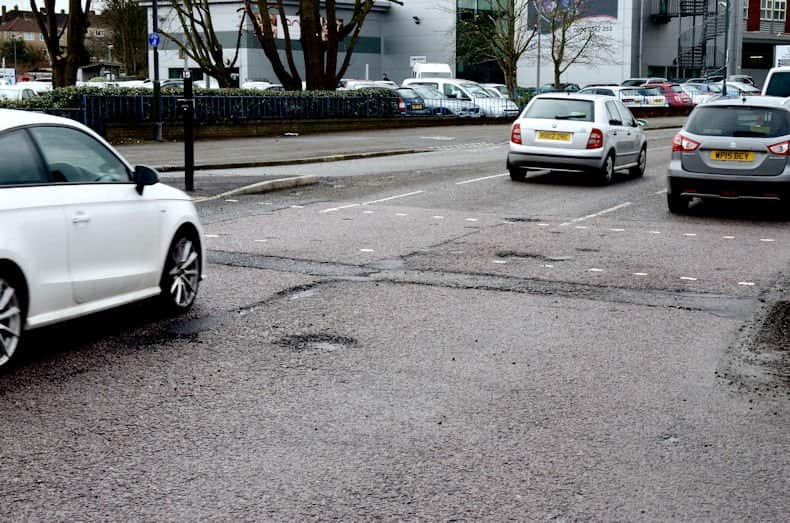
The collective name for a group, or groups, of potholes that have somehow escaped the attention of those that are supposed to carry out regular checks of our roads.
Leaves motorists with little choice but to attempt to steer their way through in their own Winter Olympics-type challenge.
Do not pass ‘Go’, spend £200: head straight to the garage for some new shock absorbers or maybe a new suspension spring or two.
- How much does it cost to replace brake pads?
- Car roof weight limits – safety guide and common mistakes
- What is a space saver wheel and how to use it?
The Sniper
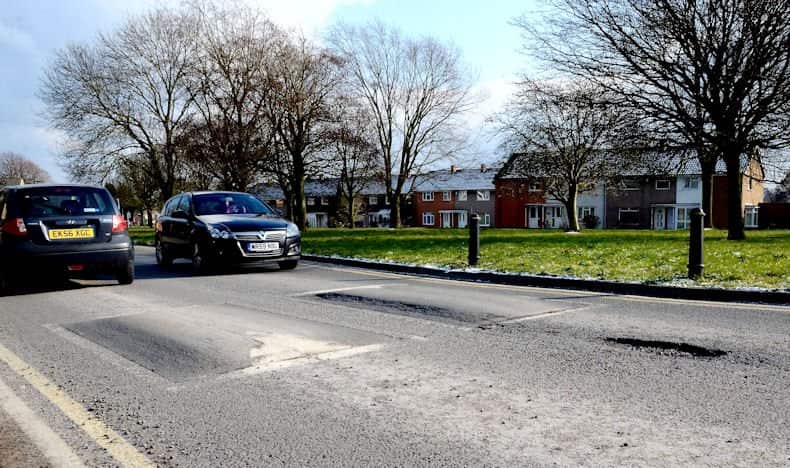
Lurking just out of sight, this one will get you when you least expect it. Of varying depths and widths this is a pothole that is hard to spot which is normally found right in the path of your wheels.
Hitting one of these at speed will cause a sudden jolt that does your wheels and suspension parts no good whatsoever.
Other road surface defects
The Alligator
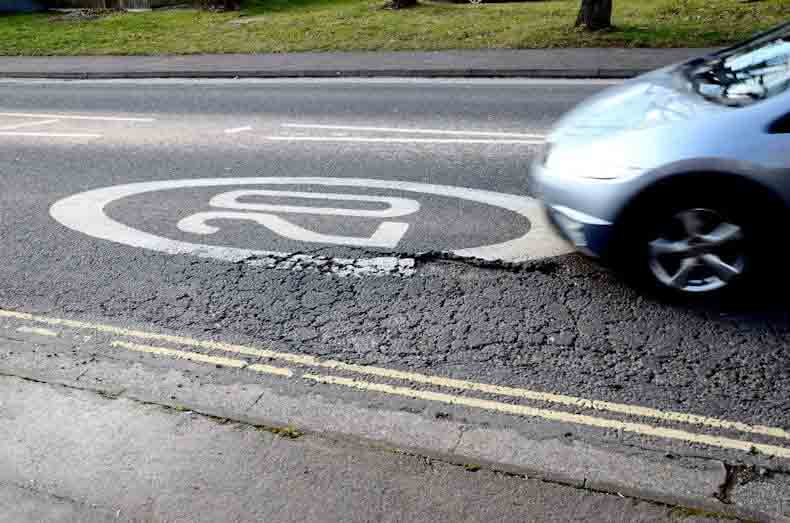
It might not have teeth yet, but you won’t have to wait long.
These are no longer just found in Florida: sadly a plethora of crazy crack patterns just like an alligator’s skin are there for all to see on Britain’s roads – no need to book a wildlife trip.
What’s more, they tend not to be a priority for fixing … in other words: they’ll fix in it 'in a while crocodile'.
The Canyon
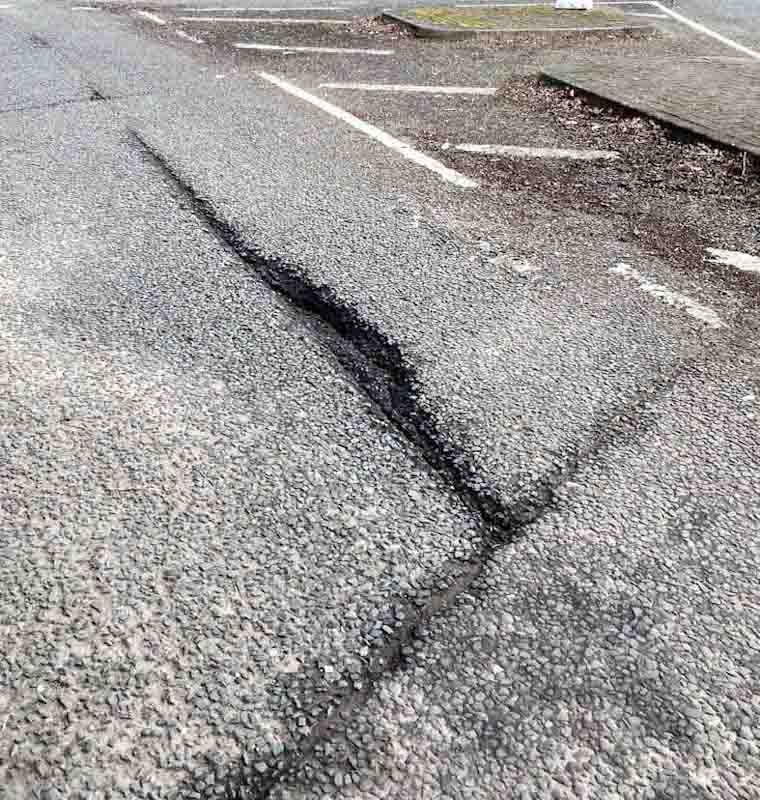
Grand it isn’t! When construction joints open up, chasms are created. Water gets in making matters worse until a river runs through it … and wheels fall into it. Bad news for drivers and vehicles, but a complete nightmare for two-wheelers.
The Fade to Grey
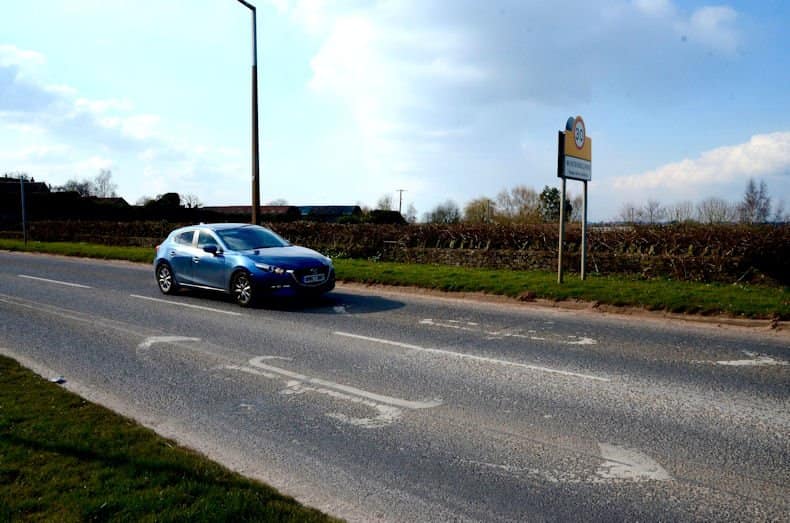
Camouflage is best used by the army and a faded zebra crossing is no longer a black and white issue.
Road markings you can’t read or see are an all-too-common sight, or perhaps that’s not quite the right way of putting it. Whatever the case: they are as much use to road users as the proverbial chocolate teapot.
The Great Beyond
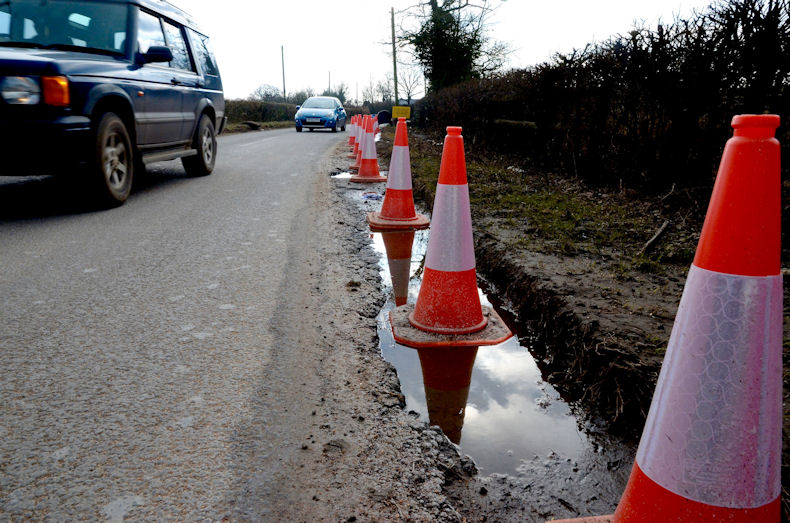
The edge of the road starts to fall away leaving less and less to drive on. And in the words of the REM song of the same name, this can easily lead to cyclists ‘crashing to the ground’. Unfortunately, councils generally have nothing up their sleeves to sort this out unless it poses a real hazard to road users.
The Groundhog
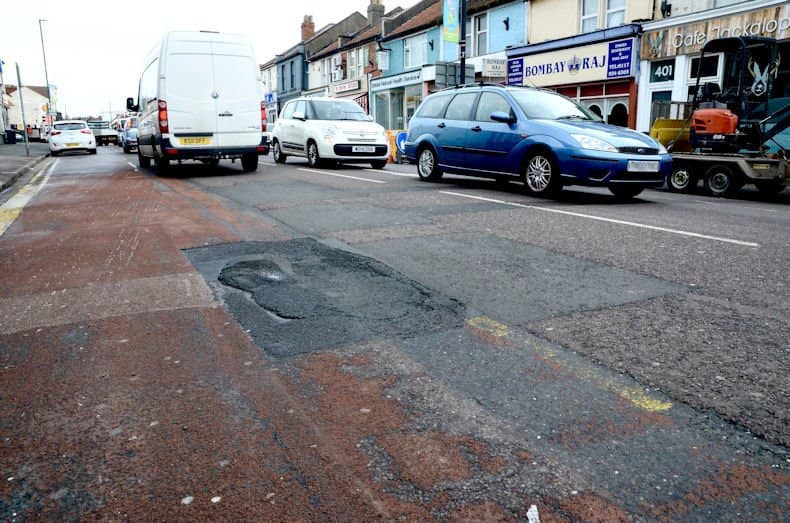
You don’t have to go to Punxsutawney, Pennsylvania to find one of these, you can find plenty right here in good old Blighty.
Borne of the ‘patch and dash’ approach to road maintenance this one recurs more often than Bill Murray’s day or a bad case of heartburn.
If only they’d fixed it properly the first time round, there wouldn’t be so ‘many unhappy returns’.
The Harbinger
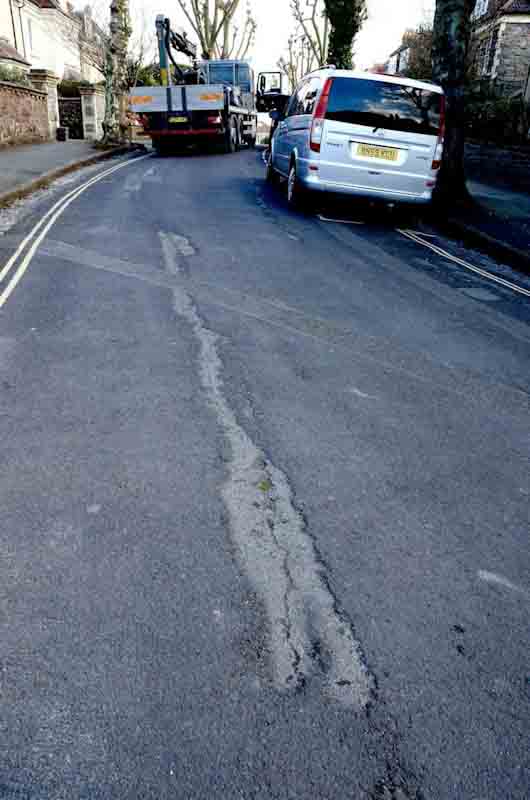
The sign of things to come. General cracking that will soon bring doom and gloom to drivers as water gets into the cracks, freezes and expands, further breaking up the road surface.
Perhaps unsurprisingly, not usually prioritised for urgent repair.
- Learner driver insurance - from 1 day to 5 months
- RAC Temporary Car Insurance from 1 hour to 30 days
- Mobile mechanic or local garage?
The Iron Maiden
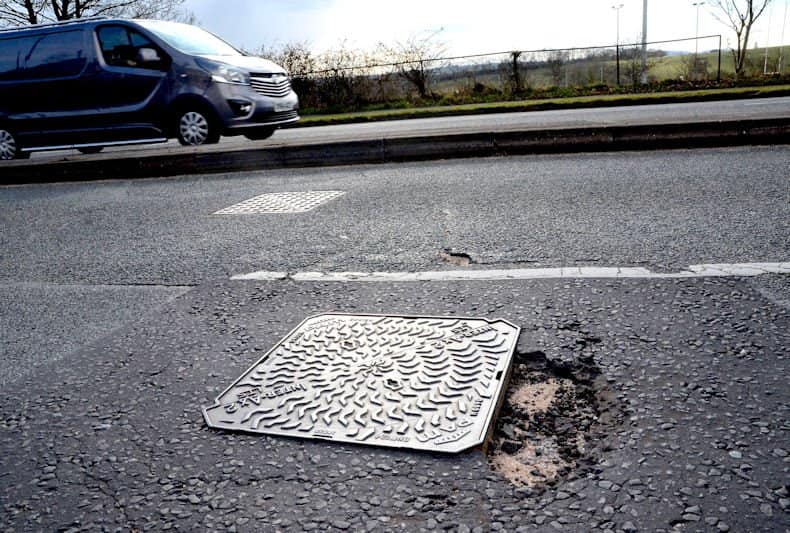
You might spot a number of these beasts. They’re cracks or holes that emerge from iron covers or grates in the road surface. Often not prioritised for repair, but try explaining that to a cyclist.
The Little Devil
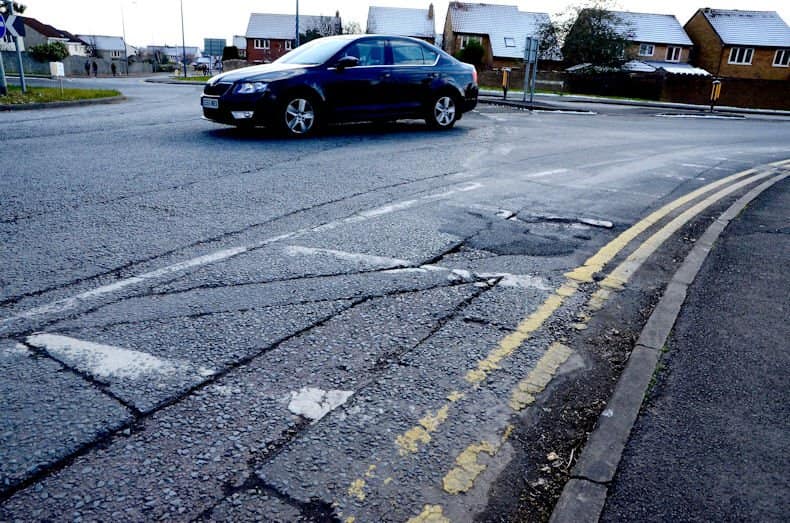
A little ‘difference in level’ might not seem like a big thing, but these tricky customers can be demon-like for unwitting vulnerable road users who encounter them.
They often occur where repairs to the road surface sink after utility works, leaving treacherous edges that can cause loss of vehicle control or send a cyclist tumbling.
The Moonscape
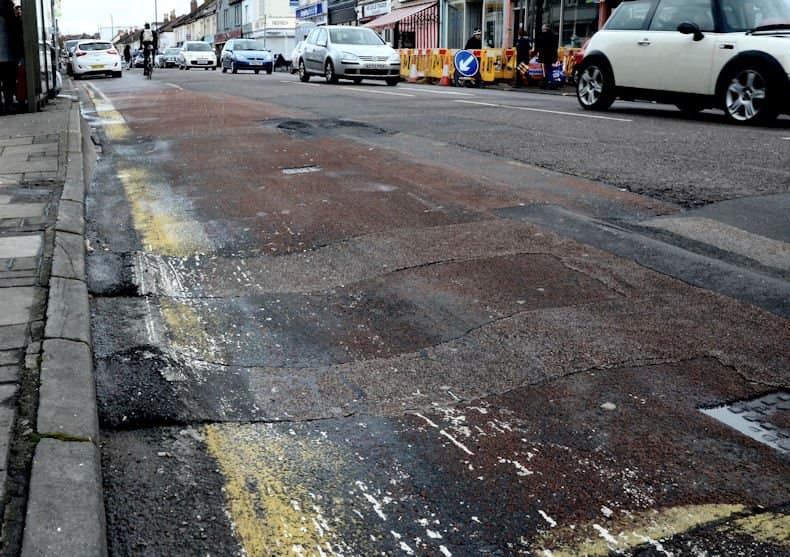
An uneven, out of this world, sunken road surface consisting of humps, bumps and craters. Often the result of poor workmanship or the use of poor materials. Very uncomfortable to drive over and at its worst could give passengers all the effects of whiplash without the crash.
- Car registration years – the complete number plate guide
- What is ESP? Vehicle safety guide
- Advice for driving in heavy rain and floods
The Patchwork Quilt
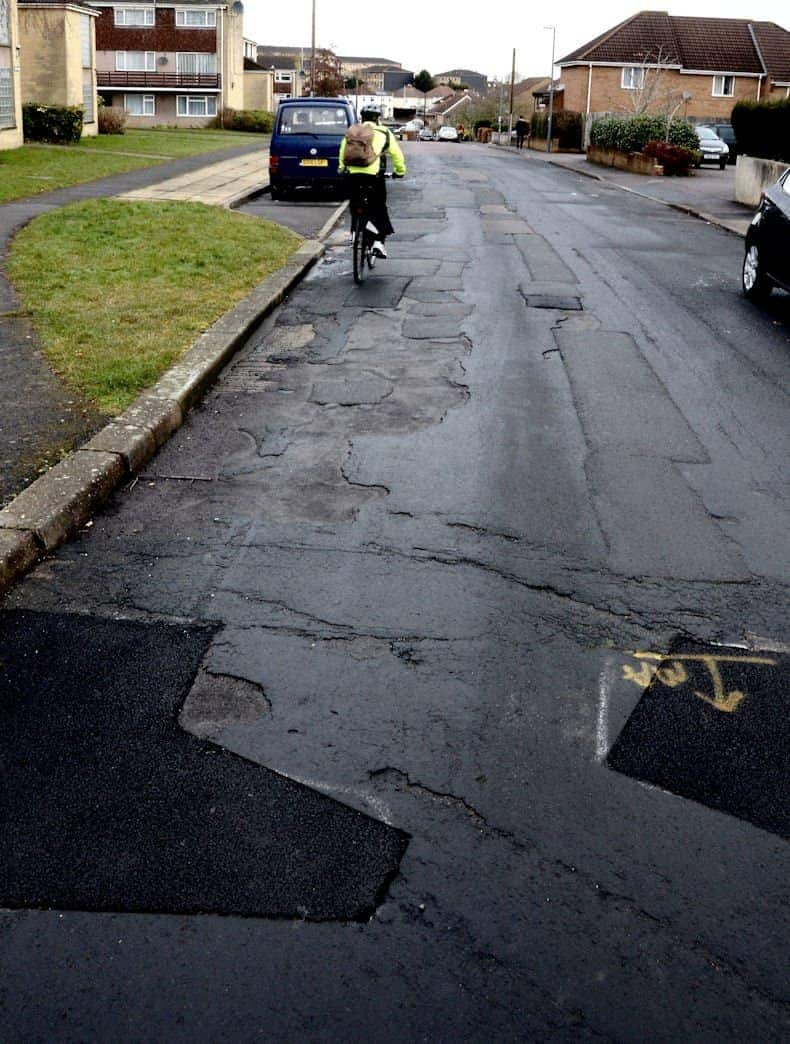
Not as visually appealing as something you put on a bed, the road version is a hotchpotch of unpleasantness.
General deterioration and a proliferation of poor repairs makes negotiating one of these a real challenge for driver and car, let alone anyone on two wheels. It’s time to get the big road surfacing machine out.
The Pebbledasher
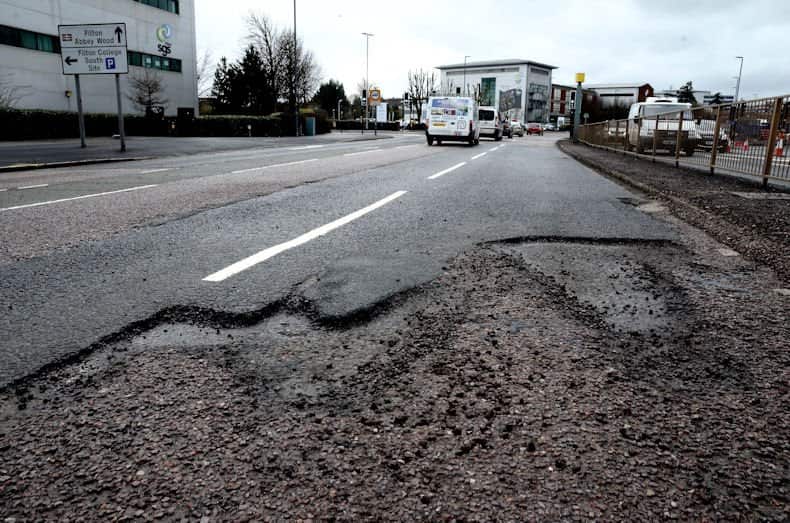
You may hear this before you see it. A crumbling road surface beneath your tyres causes bits of asphalt to fly up against the underside of your vehicle, or worse still against its paintwork.
Often found hiding along colder routes at the mercy of the elements, these stretches of road could single-handedly keep bodywork specialists doing overtime for years to come.
The Rumblestiltskin
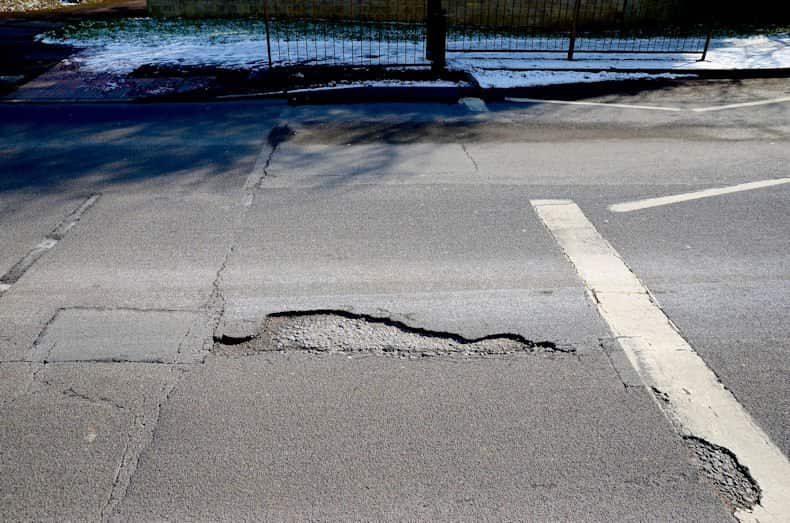
Unfortunately not a fairy tale, but grim nevertheless. General wear that turns roads into rumble strips designed to stop drivers straying from the carriageway rather than smooth surfaces for driving. Bet you don’t see these in Germany.
The Rutger Howler
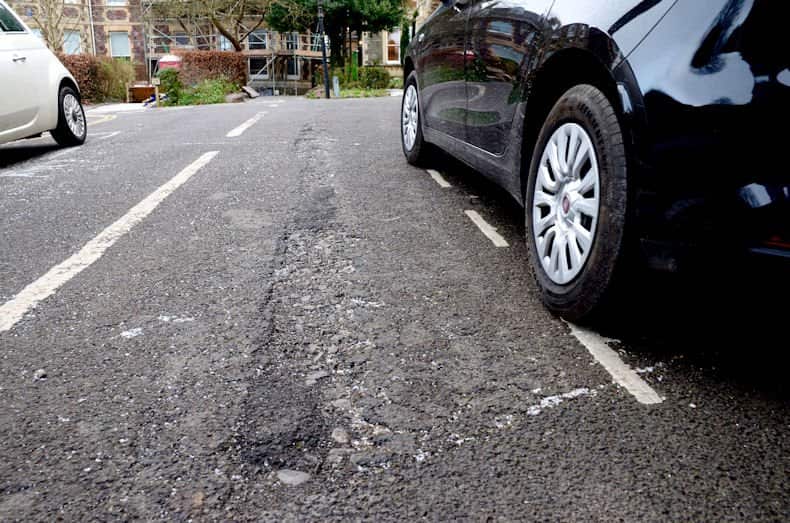
A long depression in the road surface that is truly depressing. Get your wheels stuck in one of these and you’ll know about it from both the noise and the steering difficulties. Can lead to water ‘ponding’ effects. Pretty … appalling.
The Unwisecrack
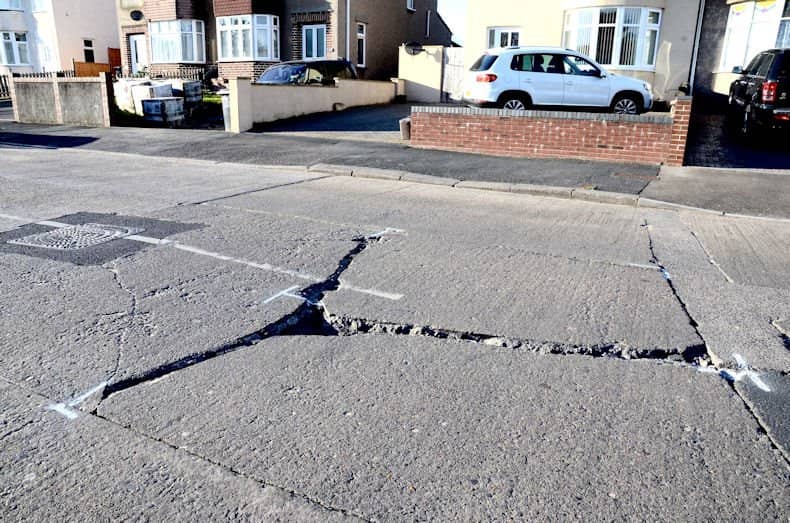
Not the least bit funny, but definitely cutting. First appearing as a little crack in an otherwise smooth road surface, it could easily be the sign of something far worse: a landslip where the carriageway literally crumbles away into a rock face.
The Windermere
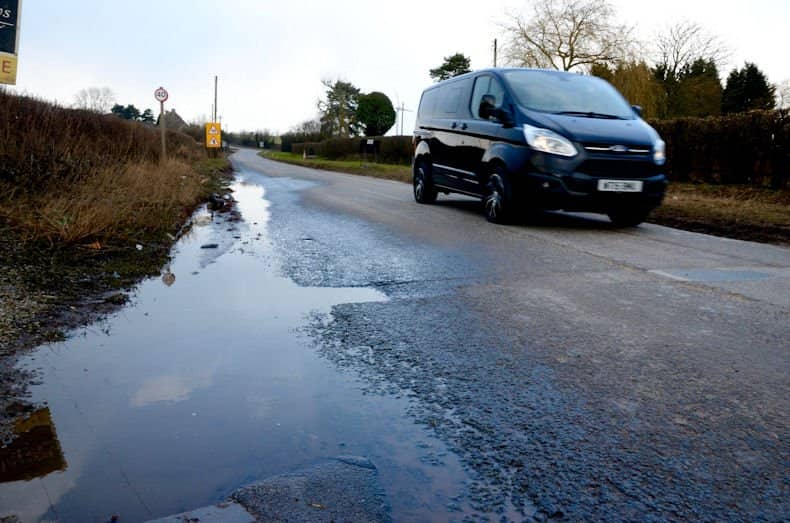
It’s a low point for every motorist when low spots in the road pool water forcing drivers to change course, possibly into danger.
We all love the Lake District, but standing water and roads really don’t mix. Roads should be for driving, not sailing.

RAC sale – up to 33% off*
• Roadside cover from £5.29 a month†
• We get to most breakdowns in 60 mins or less
• Our patrols fix 4/5 breakdowns on the spot


